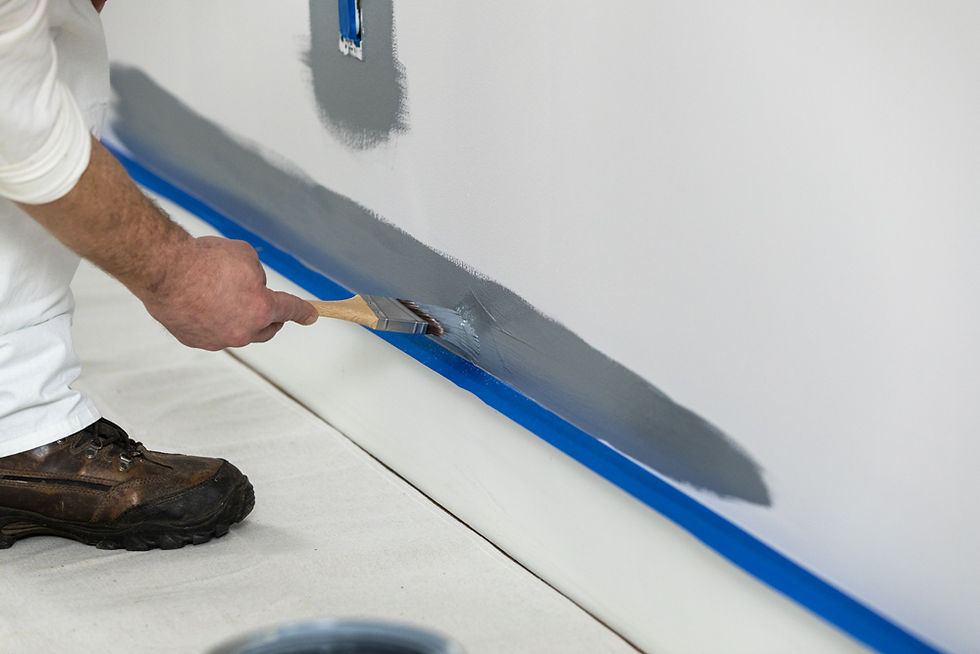Painting Stone Tile, Step by Step
- Matt Weber

- Jan 9, 2023
- 3 min read

Changing the color of stone tile can be an easy way to make a big improvement when updating a kitchen. Most popular tile types can be painted, including ceramic, natural stone and unglazed quarry tile. Paint doesn’t easily stick to glazed tile, so any glaze on the tile should first be removed by sanding.
No matter what type of stone tile you want to paint, it must be clean and free of dust, dirt and grime. A kitchen backsplash will also have been exposed to cooking oils that leave a residue on the tile, which may be difficult to see with the naked eye. Even if you plan to sand the tile, the surface should first be cleaned, or the residue will clog up the sandpaper. Careful surface preparation will be the key to a successful paint job.
Step 1: Mix dish detergent with warm water then use it to scrub the tile surface with an abrasive sponge, a stripping pad, or a stiff-bristle brush. Rinse the tile thoroughly and allow it to dry.

To speed up the surface cleaning process, we used a scrub brush attached to a reciprocating saw. You can find a variety of similar attachments from Recipro Tools.
Step 2: To remove the glaze from tile, sand the surface with 120-grit abrasive. An orbital sander will speed up the process.

Sand the tile until the entire surface has dulled and all gloss has been removed.
Step 3: Remove all sanding dust with a damp rag, rinsing it frequently. Allow the tiles to dry completely. If the tiles are grouted in place, the grout must be dry as well.
Step 4: Use painter’s tape to mask off any areas you want to protect from paint. We recommend Frog Tape because it creates a seal when it contacts latex paint.

Step 5: Acrylic latex paint will work well, as long as the tiles are porous and clean. Another option for painting tile is latex paint specifically formulated for masonry and stucco. For a total color change, use an acrylic latex primer, especially if you're applying a light color to cover a darker stone.
Experiment with the look of the paint on spare tiles or an inconspicuous are of your project. On the project shown in the photos, we wanted a semi-transparent whitewashed look that allowed some of the natural stone character to show through. To achieve this, we thinned our primer-paint with water until we got the look we wanted.

Refer to the paint manufacturer's instructions for specific guidance on thinning the paint
(if applicable).
Step 6: Different tools will achieve different effects when applying the paint. For example, the bristles of a thin brush with help access the grout joints and apply paint to surfaces that have heavy texture or surface relief. On the other hand, a foam roller made for painting doors and trim can lay a flat, thin coat that leaves pits and pinholes unpainted for more visual contrast. Applying primer and/or paint with a sprayer is an option but requires extensive masking and ventilation.

For a semi-transparent whitewash, we thinned a primer-paint combo and applied it with a foam roller. We used a brush to touch up the grout joints but left areas of deep surface texture and relief untouched to provide visual detail and character.

A second coat of paint, if desired, can be applied as soon as the first one has dried.
You can protect the new tile surface by applying a coat of masonry sealant over the dried paint.

Paint up to the edge of electrical outlets. You can then roughen the surface of plastic outlet covers with sandpaper and paint them to match the surrounding tile.





I took another look at VBCASH88 while sorting through a few notes, and the way the information is structured made things clearer than I expected. After that, I checked VBCASH88 to compare the practical sections, and the contrast actually helped me understand both pages better.
I opened VBCASH88 again because it felt easier to navigate than the other tabs I had open. After going through the content there, I checked VBCASH88 and found it useful for validating several points I missed earlier.
While sorting through different references, VBCASH88 provided a surprisingly clear explanation of what I was trying to verify. The additional sections on VBCASH88 helped round out the rest of the details I needed to confirm.
I checked back in on VBCASH88 because I wanted a reference that didn’t feel cluttered, and this page did a good job at staying concise. I reviewed VBCASH88 next, and the way everything is displayed there made the comparison straightforward.
Informative update. I looked at asgacor and later checked asgacor to confirm additional details.